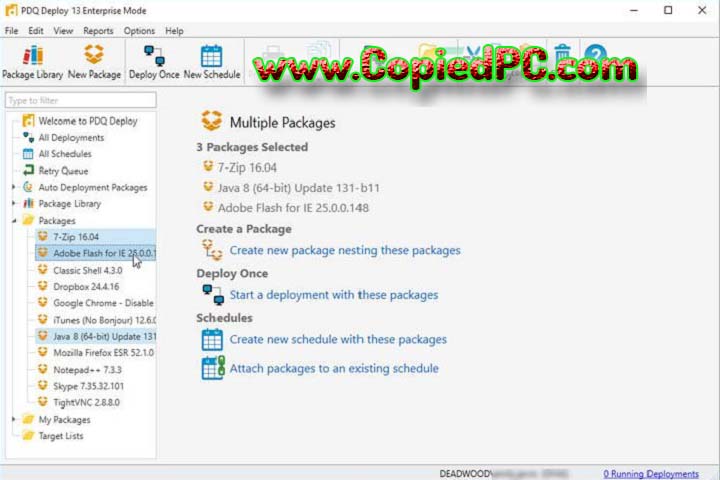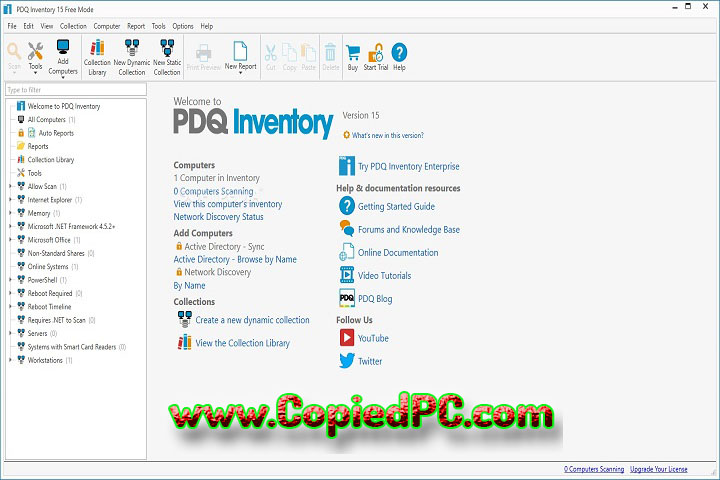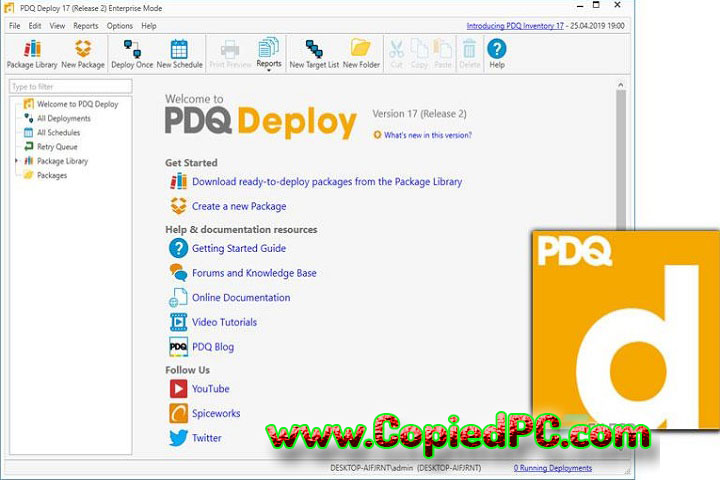PDQ Inventory : Version 19.3.626.0 (Software)
Introduction:
PDQ Inventory : Version 19.3.626.0 (Software). The most critical tasks in IT management involve inventorying organizational devices and up-to-date software. Developed to meet just that very need, PDQ Inventory 19.3.626.0 is a huge and well-used utility software tool for IT professionals to manage. And keep track of system information across different types of endpoints in a given network. Besides giving insight into hardware and software assets in a network environment. PDQ Inventory automates much of IT asset management, and saves lots of manual effort with increased accuracy.

Organisations entrust the work of compliance, making sure resources are put to good use. And dealing with the vulnerabilities of PDQ Inventory. It provides real-time data for every machine and helps IT professionals. It make smart decisions by trying to avoid issues that could affect their business. Advanced search features, custom collections, and an advanced reporting engine go hand in glove to meet. Their expectations of streamlining IT asset management in organisations.
Description:
PDQ Inventory 19.3.626.0 is a very strong tool for IT asset management, helping an organization to keep going. With the latest overview of hardware and software inventory. It targets small to large-scale environments within IT. Whereby the application scans networked devices to obtain thorough information about every machine concerning hardware configuration, installed software, and system settings. This can be further used in creating collections, reports, and alerts that will surely let the IT administrators perform their resource management. Its performance monitoring, and maintenance of security standards with much effectiveness.
You may also like :: Genymotion : Version 3.8.0
PDQ Inventory provides for automatic data updating, customizable scan scheduling, and flexible reporting. Real-time scanning allows the IT staff to view an accurate picture of the network environment. Its eliminating the need to run manual audits and minimize errors within those audits. Besides collecting data on individual machines. PDQ Inventory also enables users to create their own custom collections based on very specific sets of criteria. Its including operating system, software versioning, and security settings. These kinds of collections play a major role in organizing assets, assuring compliance, and enforcing security policies within an organization.
With the seamless integration of PDQ Inventory with its companion tool for software deployment called PDQ Deploy, administrators can easily facilitate updating software and installing security patches. Used together, PDQ Inventory and PDQ Deploy are effective in managing IT assets and software distribution.
Overview:
PDQ Inventory 19.3.626.0 boasts an incredible feature set that runs from very basic to the advanced, easily making the software a must-have for any organization seeking to improve IT asset management. From small businesses to giant enterprises, the need PDQ Inventory places on the fingertips of an IT administrator is mastery over the infrastructure by way of constant updates about hardware and software configurations. IT admins can create custom scans and reports that monitor anything from devices and software licenses to security patches and compliance concerns.
What really distinguishes PDQ Inventory, however, is its ease of use and versatility. It works effortlessly in simple to complex networks and offers tools to build an organized inventory of current assets. Set up the alerts you need based on custom triggers: recently installed software, new or removed devices, device status changes-all with proactive intent.
In addition to its core inventory functions, PDQ Inventory with integrated PDQ Deploy empowers the streamlining of operations by enabling users to automate software installations, updates, and even security patches. Thus, for an IT department, these utilities become the means for reducing downtime, improving security, and maintaining systems current with minimal human involvement. Thanks to comprehensive reporting, an intuitive interface, and real-time data gathering, it is a must-have piece in an efficient and organized process of IT asset management.
You may also like :: FocusWriter : Version 1.8.9
Software Features:
Scanning and Data Collection Automatically:
PDQ Inventory automatically performs network scans to update information on hardware and software configurations. Scans can be scheduled to run at defined intervals, or users can manually start a scan at any time. This feature provides current data and gives the IT administrator an accurate view of the network.
Real-time Monitoring and Alerts:
With real-time monitoring, PDQ Inventory automatically informs customers of any changes within the network concerning any device additions or omission, or software installations. Users will configure Alerts that get Triggered based on Events such as Software installation or System Status changes that are critical, that allows administrators to take preliminary action.
Custom Collections:
With PDQ Inventory, it’s easy to develop custom collections based on the operating system, hardware specs, or version of software installation. Therefore, these assets will be easily assembled, updated, and necessary compliance checks troubleshoot with focused attention.
Detailed reporting and export options:
You may also like :: Capture One Pro : Version 16.5.0.2494
Software Features:
Extensive reporting functionality lets users create very detailed reports of devices, software licenses, system health, and many other aspects. It provides custom reporting options, supports various export formats, including CSV, HTML, and XML, for ease in sharing information with stakeholders or its importation into other tools.
Integration of PDQ Inventory with PDQ Deploy:
Because of that, PDQ Inventory will go hand in glove with the program PDQ Deploy for speedier and automated software deployment and patch management. It will be very easy to determine which machines need updates or which software is not present, and users can then deploy them directly from the PDQ Inventory interface to make such a process seamless to maintain the systems up-to-date.
Search and Filter Capabilities:
PDQ Inventory is a powerful tool that allows users, through advanced searching and filtering, to identify devices or software in a remarkably short amount of time based on certain parameters. It’s quite useful on large networks where tracking a particular system or software version might take a long time to do manually.
Customizable scan profiles:
Users can create scan profiles to focus on specific installed software, hardware specification, or status areas of interest. The result is a customized platform that ensures only the capture of irrelevant data, hence reducing network load by way of improving efficiency in scanning.
License Management:
Software Features:
PDQ Inventory has utilities for managing software licenses across the organization. License usage and expiration can be tracked by administrators to be in compliance with software licensing agreements, avoid overuse, and save money on unnecessary license purchases.
The Offline Data Collection:
PDQ Inventory has the ability to scan for offline devices; it updates devices’ statuses once they come online. It’s very critical in recordkeeping, especially in an environment that has more chances of devices getting disconnected and/or taken offsite.
Role-Based Access Control (RBAC):
Role-based access involves allowing organizations to restrict the access or use of the data, as well as features of PDQ Inventory, depending on the role of the users within the organization. This feature allows only the most authorized personnel to disclose sensitive information, reducing the potential for data exposure.
User-friendly interface:
PDQ Inventory features an easy-to-navigate interface that any user, whether highly technical or not, can efficiently use to their advantage. Its intuitive navigation system and well-organized menus provide easy access to its features, including setting up scans, creating reports, and more.
Cross-platform compatibility:
This makes it the support of PDQ Inventory for the widest range of Windows operating systems, enabling the IT departments to work in really diverse environments with this tool. It is compatible and so can be used across organizations with different kinds of devices.
System Requirements:
Following is the minimum system requirement to install and run the PDQ Inventory 19.3.626.0 effectively:.
Operating System:
Windows 10, Windows Server 2016, Windows Server 2019, or newer; 64-bit versions recommended.
Processor:
Intel Core i3 or equivalent minimum; Intel Core i5 or higher recommended for larger networks. Memory (RAM): Minimum 4 GB RAM, though 8 GB or more is recommended for optimal performance on large networks. Storage: Installation requires at least 250 MB free disk space, additionally more space depending on requirements for all scan data and reports. Network Requirements: TCP/IP network access to all computers that are to become targets. And like PDQ Inventory, the utility requires administrator-level access to target systems to perform scanning and monitoring. .NET Framework: .NET Framework 4.8 or later. Additional requirements for integration: The PDQ Inventory and PDQ Deploy should be installed on the same machine for better integration with PDQ Deploy.
Download Link : Here
Your File Password : CopiedPC.com
File Version & Size : 19.3.626.0 | 90 MB
File type : compressed/Zip & RAR (Use 7zip or WINRAR to unzip File)
Support OS : All Windows (64Bit)
Virus Status : 100% Safe Scanned By Avast Antivirus


